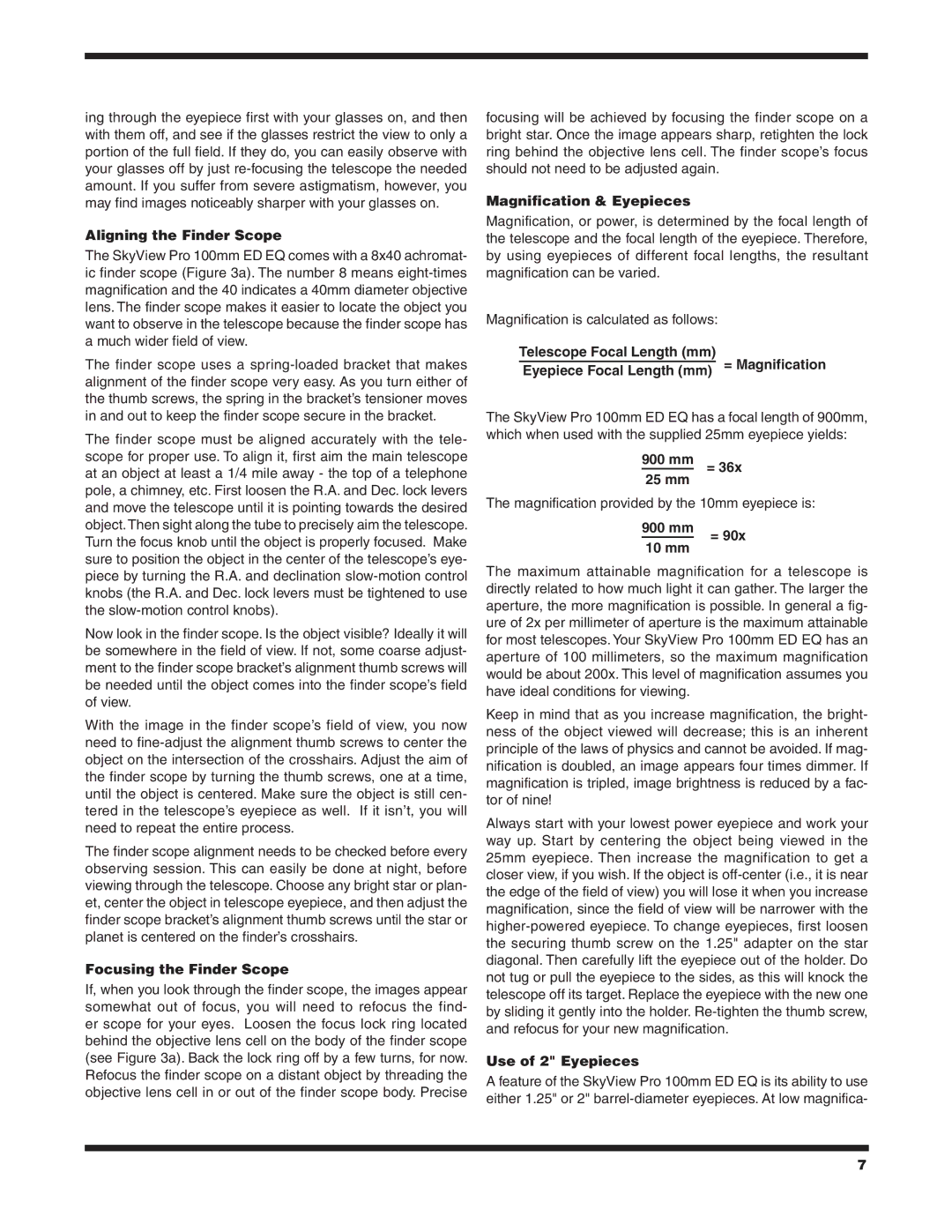
ing through the eyepiece first with your glasses on, and then with them off, and see if the glasses restrict the view to only a portion of the full field. If they do, you can easily observe with your glasses off by just
Aligning the Finder Scope
The SkyView Pro 100mm ED EQ comes with a 8x40 achromat- ic finder scope (Figure 3a). The number 8 means
The finder scope uses a
The finder scope must be aligned accurately with the tele- scope for proper use. To align it, first aim the main telescope at an object at least a 1/4 mile away - the top of a telephone pole, a chimney, etc. First loosen the R.A. and Dec. lock levers and move the telescope until it is pointing towards the desired object.Then sight along the tube to precisely aim the telescope. Turn the focus knob until the object is properly focused. Make sure to position the object in the center of the telescope’s eye- piece by turning the R.A. and declination
Now look in the finder scope. Is the object visible? Ideally it will be somewhere in the field of view. If not, some coarse adjust- ment to the finder scope bracket’s alignment thumb screws will be needed until the object comes into the finder scope’s field of view.
With the image in the finder scope’s field of view, you now need to
The finder scope alignment needs to be checked before every observing session. This can easily be done at night, before viewing through the telescope. Choose any bright star or plan- et, center the object in telescope eyepiece, and then adjust the finder scope bracket’s alignment thumb screws until the star or planet is centered on the finder’s crosshairs.
Focusing the Finder Scope
If, when you look through the finder scope, the images appear somewhat out of focus, you will need to refocus the find- er scope for your eyes. Loosen the focus lock ring located behind the objective lens cell on the body of the finder scope (see Figure 3a). Back the lock ring off by a few turns, for now. Refocus the finder scope on a distant object by threading the objective lens cell in or out of the finder scope body. Precise
focusing will be achieved by focusing the finder scope on a bright star. Once the image appears sharp, retighten the lock ring behind the objective lens cell. The finder scope’s focus should not need to be adjusted again.
Magnification & Eyepieces
Magnification, or power, is determined by the focal length of the telescope and the focal length of the eyepiece. Therefore, by using eyepieces of different focal lengths, the resultant magnification can be varied.
Magnification is calculated as follows:
Telescope Focal Length (mm)
Eyepiece Focal Length (mm) = Magnification
The SkyView Pro 100mm ED EQ has a focal length of 900mm, which when used with the supplied 25mm eyepiece yields:
900 mm = 36x
25 mm
The magnification provided by the 10mm eyepiece is:
900 mm | = 90x | |
10 mm | ||
|
The maximum attainable magnification for a telescope is directly related to how much light it can gather. The larger the aperture, the more magnification is possible. In general a fig- ure of 2x per millimeter of aperture is the maximum attainable for most telescopes. Your SkyView Pro 100mm ED EQ has an aperture of 100 millimeters, so the maximum magnification would be about 200x. This level of magnification assumes you have ideal conditions for viewing.
Keep in mind that as you increase magnification, the bright- ness of the object viewed will decrease; this is an inherent principle of the laws of physics and cannot be avoided. If mag- nification is doubled, an image appears four times dimmer. If magnification is tripled, image brightness is reduced by a fac- tor of nine!
Always start with your lowest power eyepiece and work your way up. Start by centering the object being viewed in the 25mm eyepiece. Then increase the magnification to get a closer view, if you wish. If the object is
Use of 2" Eyepieces
A feature of the SkyView Pro 100mm ED EQ is its ability to use either 1.25" or 2"
7
